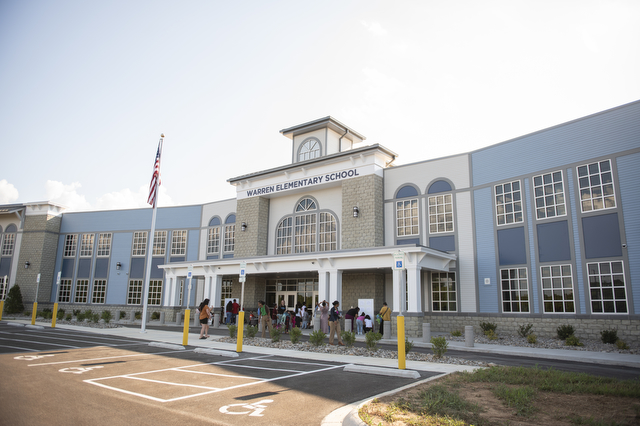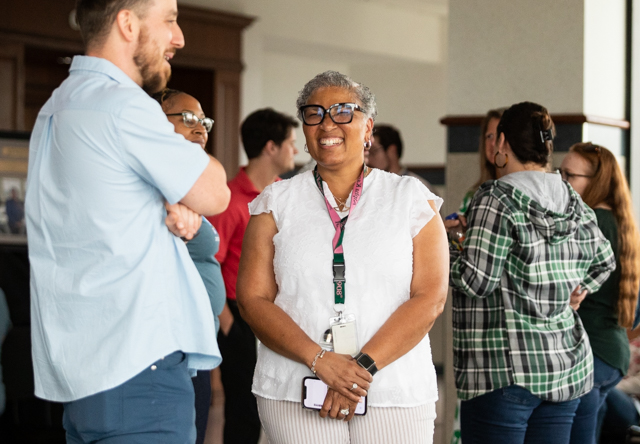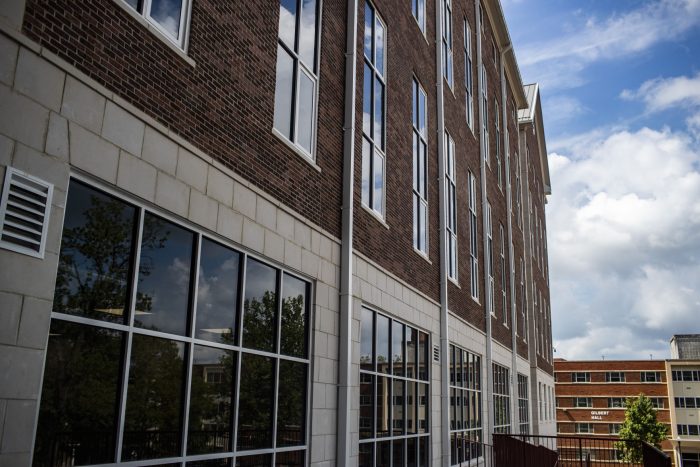‘Police work has changed tremendously’
Published 3:50 pm Friday, September 14, 2012

- Bowling Green Police Department in 1903. (Photo Courtesy of Special Collections-WKU)
Retired Bowling Green police officer Bernie Cox remembers Bowling Green’s downtown as an exciting place to patrol when he started work with the force in 1970 with entertainment venues, bars, restaurants and shopping. In the years before a mall in Bowling Green, it served as a major shopping area.
“It was just a, I would say, a hustling and a bustling kind of place,” Cox said.
Trending
He said his time as a patrolman in Bowling Green was one of the most rewarding he ever had. He liked having contact with the citizens and being able to answer calls for help directly.
“There was a lot of stuff, a lot of activity,” Cox said. “You know, young police like something to do, not just sit around.”
A lot has changed since Cox patrolled Bowling Green’s streets. Police work has become much more scientific, along with an emphasis on better note taking and report writing, he said. He remembers one time in his early days on the force when an officer came to court with his notes on a matchbook.
“Police work has changed tremendously,” Cox said.
Early history
The history of the Bowling Green Police Department can be traced through documents back to 1823, although law enforcement in the town likely predates that, according to a history of the department written by Levi Word and Bill Key. They finished the history in 1997.
Trending
Word, who retired from the BGPD in 2000, and Key shared a passion for history, but realized that there was no history of the BGPD, at least to their knowledge, Word said. They requested permission from then-chief Gary Raymer to compile the document.
“A lot of that information would have been lost if we hadn’t taken the time to go do it,” Word said.
He was surprised they were able to collect information as far back as 1823 by looking at information collected both in the Kentucky Museum at Western Kentucky University and from archives in Frankfort, he said.
Word said he’s proud of what he and Key were able to accomplish, especially compiling a list of all the chiefs of police and early police force leaders, back to James Keel, who served as the city’s “Captain of Pattrole” in 1823.
At the time, Keel’s pay consisted of not having to pay town taxes for the duration of his service, according to Word and Key’s history. The first law enforcement officers were called “watchmen,” and by 1825 a system was set in place where members of patrols around town could be fined for refusing to do their duty. By 1838, members of the patrol were paid two shillings an hour.
The city outgrew its part-time police force as it grew into a regional trading center as first steamboats and later the railroad arrived. By 1861, at least the head of the police, then called a marshal, worked full time, according to the history. Part of the marshal’s duty was the collection of taxes, fines and proceeds from auctions. There was also a police court and police judge in addition to the county court system and sheriff’s office with its authority restricted to city limits.
Bringing in diversity
Starting in 1893, openings on the police force were filled in December during meetings of the city council as established by the state legislature, according to the history. Appointees were nominated by the police committee and confirmed through the council. For decades, they had to be white and male.
That started to change in the 1960s under Police Chief Wayne Constant, according to the history. Current Bowling Green City Commissioner Joe Denning was appointed as the city’s first black police officer in 1968.
While the history lists the city’s first female officer as Mary Potter, appointed in the early 1960s, a Daily News story published in July 1957 lists the city’s first female officer as Mary J. Pillow and states that her job was to consist mostly of bookkeeping and secretarial work.
Denning was 21 when he joined the police force. He later became the second black Kentucky State Police trooper in 1970, he said. He served both in Frankfort and in Bowling Green in the early 1970s.
“I think some of the leaders at that time felt it was the right thing to do, that the city police needed to be representative of the total community,” Denning said of his appointment to the BGPD.
The call for black police officers on the Bowling Green force had been going out for at least 20 years before Denning took his place as an officer. A newspaper article published in February 1948 reports that the Colored Women’s Voters League had sent a petition with about 100 signatures to then-Mayor Henry J. Potter Sr., requesting that two black policemen be appointed to the BGPD.
The petition requested that the officers be assigned to districts where black people gathered in large numbers with the hope that the new districts would be “insured against rowdy and disorderly conduct” and that the police officers would have a positive influence on the young people in the community and prevent them from committing crimes.
He didn’t think about the historical significance of his new position at the time he was appointed, Denning said.
“It was something I just wanted to do, and that was the place,” he said.
He was fortunate to have the support of other police officers who helped him learn the ropes as a rookie, Denning said.
Though it was only a few years after integration in Bowling Green, Denning said he felt accepted by the public as a police officer.
“I did not have any problems because of my race,” Denning said.
Denning grew up during a period of segregation. Bowling Green schools integrated in 1963, according to a story in the Daily News.
He lived on Kentucky Street as a child near the train depot, he said.
“I used to play in the train station every day when I was a little fellow in the white waiting room and the colored waiting room,” Denning said.
He attended the all-black High Street High School.
“I never did have a white teacher during my elementary and high school career,” Denning said.
The idea of becoming a police officer was suggested by friends who were police officers and state troopers with whom he played basketball at the old Boys Club. The Boys Club was segregated, but Denning could play with his friends on outside basketball courts.
He took the suggestion of his friends because of a desire to help others, he said.
“I had always, since my high school days, wanted to be in a position where I could help people,” Denning said.
This desire manifested initially during high school, when he gained the respect of some of this teachers, who served as role models for Denning and his classmates.
“Those were the individuals that we as young black individuals looked up to,” he said.
Instrumental figures in his life included coach Joe Owmby, under whom he played football for four years, and Herb Oldham, his assistant basketball coach.
He had keys to both men’s cars and would serve as a driver for some of his fellow students, often taking them to doctor or dentist appointments. That kind of trust from his teachers was something Denning found remarkable, he said.
“I’ll never forget that as long as I live,” he said.
Changes in equipment
Cox began his career in the police force in Russellville in 1966 and moved to Bowling Green in 1970.
He remembers the portable radios that Bowling Green police officers used in 1970 as a luxury, because they didn’t have them in Russellville.
In 1941, Bowling Green police became the first department in the country to receive a two-way AM radio system manufactured and installed by the Motorola Co., according to the history. The system included a base station in the basement of city hall and a mobile unit on the department’s lone patrol car with a large whip antenna, according to the history. The department got FM radio equipment after World War II. Before the two-way radio system was put in place, officers had to drive past the police station every hour. The desk clerk would signal them to stop if there was a call to make.
Police cars when Cox was first an officer had no air conditioning. He also remembers sometimes getting off his shift and riding around with other officers while they worked just to keep them company. He doubts such a thing would be allowed today, he said.
At the time, crime was a major problem in the city, Cox said.
“Bowling Green was known as ‘Little Chicago,’ ” he said.
It got that title for the number of serious crimes that took place in the city, including a high number of murders and bombings, Cox said.
An example of the kind of crime dealt with during that era can be seen in an August 1963 story in the Daily News, which reports that an unexploded six-stick dynamite bomb was found under the car of Detective Sgt. Wayne Constant, who was a nominee for Bowling Green police chief at the time.
Bowling Green experienced a rash of dynamite bombings in the early 1960s, before Cox joined the force. A newspaper story published in August 1961 and written by Tom Duncan of The Courier-Journal’s Southern Kentucky Bureau stated that there had been nine bombs planted during the course of 10 months, though three had failed to explode. Disgruntled bootleggers upset after a September 1960 vote to end a 21⁄2-year period of prohibition in the city is given as one possible source of the bombings, though they had also been tied to troubles revolving around pinball machines, and one of the targets of the dynamite bombs was the office of Siddens Music Co., which distributed pinball machines.
In a May story, Duncan reported on the sixth dynamiting in 71⁄2 months, which demolished the Horseshoe Beer Depot. Police at the time attributed the dynamiting to a beer price war. The store had been selling beer at prices lower than many competitors.
Recent changes
Police Chief Doug Hawkins has seen many changes at the BGPD since he became a Bowling Green police officer in 1990. At the time, the department was operating out of multiple facilities before consolidating at its present location in 1997. The building was remodeled and expanded in 2004.
The approach to vehicles has also changed since Hawkins was a rookie cop. Then, the department operated with a much smaller fleet of vehicles that wore out quickly because they were used by multiple officers, as one would go off shift and another came on.
“The seat never had the time to cool off,” Hawkins said.
The whole fleet could become worn out in three years because so many miles were put on each car, he said. The approach has since changed to use more vehicles, which last longer because they are driven less often.
Technology used by the department has also changed significantly, with in-car computers and cameras and digital technology used in almost every part of the job, Hawkins said.
Kevlar vests also became more commonly used by police officers in the 1990s as technology for bullet-resistant vests improved and nationwide a number of police officers were killed in the line of duty, he said.
The way police officers interact with the community has also changed since Hawkins joined the BGPD. Early in his career, the department adopted a community policing concept that involved more interaction with the community on a consistent basis, where previously police would only engage the public when they needed help with something specific.
Such an approach helps to better serve the public, Hawkins said.
The BGPD was also the originator of the post of international communities liaison, he said. The position was established in July 2008 and later became a citywide post.
One of Hawkins’ priorities as chief now is to continue to bring people into the force who are of high character and motivated to serve the community. Those people will assure the future of the police force, he said.
Kevlar vests became more commonly used by police officers in the 1990s as technology for bullet-resistant vests improved and nationwide a number of police officers were killed in the line of duty.







